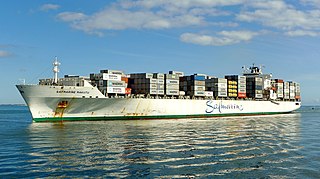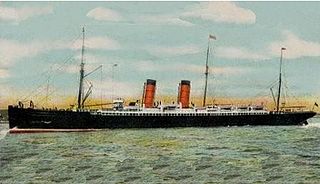
Kaiser Wilhelm der Grosse was a German transatlantic ocean liner named after Wilhelm I, German Emperor, the first monarch of the German Empire.

The Union-Castle Line was a British shipping line that operated a fleet of passenger liners and cargo ships between Europe and Africa from 1900 to 1977. It was formed from the merger of the Union Line and Castle Shipping Line.

Safmarine, short for South African Marine Corporation, and latterly South African Marine Container Lines, was a South African shipping line, established in 1946, which offered freight transport services with cargo liners and container ships. It was bought by Maersk Line in 1999, and was fully integrated into that company in 2020. It also operated passenger vessels and specialised cargo ships.

RMS Windsor Castle was the largest passenger and cargo liner operated by the Union-Castle Line on its Cape Mail service between Britain and South Africa. Completed in 1960, the new Royal Mail Ship was notable for the high standard, if conservative, design of her public rooms in a "traditional" first class and "contemporary" tourist class configuration, which by clever arrangement, afforded both classes public rooms and open-deck areas facing forward and aft. The spacious passenger lounges and dining rooms were designed by eminent British architects. Windsor Castle was air-conditioned throughout the passenger and crew areas. Facilities included a fully equipped hospital, two outdoor swimming pools, a health spa and a theatre/cinema. A large amount of dry and refrigerated cargo space, cargo wine tanks and a specie (bullion) room, were also fitted.

RMS Transvaal Castle was a British ocean liner built by John Brown & Company at Clydebank for the Union-Castle Line for their mail service between Southampton and Durban. In 1966 she was sold to the South Africa-based Safmarine and renamed S.A. Vaal for further service on the same route. Following cessation of the service between the UK and South Africa in 1977 the ship was sold to Carnival Cruise Line and rebuilt in Japan as the cruise ship SS Festivale, re-entering service in 1978. In 1996 she was chartered to Dolphin Cruise Line and renamed IslandBreeze. In 1998 the ship was sold to Premier Cruise Line, which renamed her The Big Red Boat III. Following the bankruptcy of Premier Cruise Line in 2000, The Big Red Boat III was laid up until 2003 when she was sold to scrappers in Alang, India. She was renamed The Big Red Boat for her final voyage to the scrapyard.

RMS Etruria was a transatlantic ocean liner built by John Elder & Co of Glasgow, Scotland in 1884 for Cunard Line. Etruria and her sister ship Umbria were the last two Cunarders that were fitted with auxiliary sails. Both ships were among the fastest and largest liners then in service. Etruria was completed in March 1885, twelve weeks after Umbria, and entered service on the Liverpool – New York route.

HMS Pretoria Castle (F61) was a Union-Castle ocean liner that in the Second World War was converted into a Royal Navy armed merchant cruiser, and then converted again into an escort carrier. After the war she was converted back into a passenger liner and renamed Warwick Castle.

RMS Arundel Castle was a British ocean liner and Royal Mail Ship which entered service in 1921 for the Union-Castle Line. A previous vessel of the same name was built in 1864 by Donald Currie & Co. and sold in 1883, whereupon it was renamed Chittagong. Originally laid down as the Amroth Castle in 1915, building was delayed by the First World War. She was eventually launched on 11 September 1919. She was completed on 8 April 1921 and in 22 April 1921 the ship departed from Southampton on her maiden voyage to Cape Town. During World War 2 she was requisitioned by the Admiralty to serve as a troopship. After the war she resumed passenger service, eventually being scrapped in 1959.

MS Oslofjord was an ocean liner built in 1938 by A/G Weser Shipbuilders, Bremen, Germany, for Norwegian America Line. She was of 18,673 gross register tons and could carry 860 passengers. She would have an uneventful career until 1939 were two separate incidents happened. One from 27 April 1939, where she collided with the American an pilot boat, and another where she struck a mine sinking her.

MS Astor was a cruise ship that most recently sailed for Cruise & Maritime Voyages' Transocean Tours subsidiary, under which she operated voyages to Europe, South Africa, and Australia.

RMS Pendennis Castle was a Royal Mail Ship, passenger and cargo liner operated by the Union-Castle Line. The vessel served 1959-1976 on a regular route between the UK and South Africa for the Southampton to Las Palmas, Cape Town, Port Elizabeth, East London and Durban "Cape Mail" service. After the vessel's disposal by Union-Castle, she was re-named consecutively Ocean Queen, Sinbad, then Sinbad I, however the ship did not return to commercial service.

Furness Bermuda Line was a UK shipping line that operated in the 20th century. It was part of Furness, Withy and ran passenger liners between New York and the British Overseas Territory of Bermuda from 1919 to 1966.

SS New Australia was a UK-built turbo-electric passenger steamship that had a varied career from 1931 to 1966. She was built as the ocean liner Monarch of Bermuda, was a troop ship in the Second World War and was damaged by fire in 1947.

SS Queen of Bermuda was a British turbo-electric ocean liner that belonged to Furness, Withy & Co Ltd. Its Furness Bermuda Line subsidiary operated her between New York and Bermuda before and after the Second World War. During the war she served as first an armed merchant cruiser and then as a troop ship.
RMS St Helena was a passenger-cargo liner, built in 1963 as Northland Prince, operated by the St. Helena Shipping Company that operated between Britain and South Africa via the British colony of Saint Helena between 1978 and 1990.

Edinburgh Castle was an ocean liner operated by the Union-Castle Line in service between Britain and South Africa during the mid 20th century. She and her sister ship the RMS Pretoria Castle were built to replace the Warwick Castle which was lost during World War 2.

Edinburgh Castle was a Union-Castle Line steam ocean liner and refrigerated cargo ship that was launched in 1910 and sunk in 1945. In peacetime she was in liner service between Great Britain and South Africa.

MS Ruahine was a passenger ship that operated in the mid-20th century, primarily for the New Zealand Shipping Company.

SS Grampian was a transatlantic ocean liner that was built in Scotland in 1907 and scrapped in the Netherlands in 1925. She was operated originally by Allan Line, and later by Canadian Pacific Steamships. In the First World War she remained in commercial service but carried Canadian troops. In 1919 she survived a collision with an iceberg. In 1921 she was gutted by fire while being refitted. The refit was abandoned, and in 1925–26 she was scrapped.



















